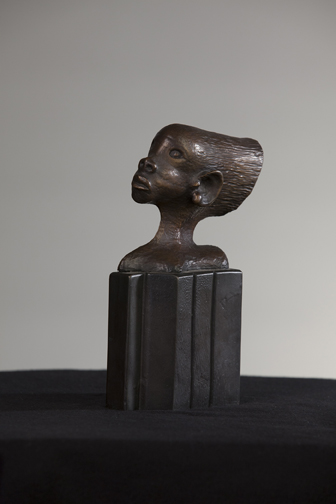This 35-year retrospective, consisting of 52 sculptures (some presented in small editions) and nine digital photographs, offers a revealing cross section of Charles Tatum’s work dating from 1973 until 2008, the year the artist passed. Consistent throughout the exhibition is an ongoing exploration of the influence of traditional African art and art of the Diaspora on the work of this contemporary African-American sculptor.
A self-described “folk artist,” Tatum’s body of work belies this limited niche, demonstrating a thorough understanding of a broader range of issues that at times appears to have veered into mainstream territory, while retaining a “folk persona.” Within a modernist tradition, such inquiries would carry a more formal, intellectual, aesthetic, issue-driven agenda. Tatum’s inquiry is less formal and more cultural, spiritual, intuitive and e-motional (energy-in-motion), offering a platform for understanding and embracing non-traditional approaches to the creative process, i.e. improvisation.
Wood was Tatum’s principle medium (incorporating bronze, other metals, and glass at various points), and he faithfully relied on his third eye to discern moving forces in the wood to guide his carving. His creative process excluded the use of preliminary sketches, drawings, or maquettes and instead used cultural intuition, incorporating at one extreme appropriated objects operating outside the vocabulary of neo-traditionalism’s near-perfect replications of traditional African sources. A good example is Homophibian (2007), with its network of cultural and traditional markings, its sense of African elongation and non-Western proportion. On the other extreme, Tatum produced sculpture that captured the pure abstract, energetic, gestural thrust that one finds among the Baga, Dogon, or Bobo cultural groups, exemplified in A Song to a Sorghum Flower (1974) with its provocative metal and wood telescopic extension.
From the “South Coast Flower Series,” King Flower (2004) is an interesting improvised assemblage composed of a small stack of salvaged metal tubes, a pair of “leaves” that were once metal flaps on a djembe drum growing out of the salvaged metal, crowned by a carved wooden blossom whose interior is on the verge of spouting spores—suggesting an impending environmental hazard. The sculptor would eventually team up with glass-crystal artist Dutch Schulze to create a series of works taken from molds for his bronzes, pulled from the wood originals. Head of a Young Maiden (1996) is a successful merger between this art and technology. Exhibited in a sequence of wood, bronze and glass, the glass pieces function as sculpted prisms whose surfaces emit a “mellowed” out internal light. The head’s uplifted positioning recalls those found on Augusta Savage’s sculpture The Harp (1939).
Sometime later, Tatum explored digital photography and collaborated with photographer David Czuba for the “Environmental Portrait Series,” superimposing his sculpture onto digitally altered visual fields. Cosmic Woman (1997) provides an excellent example of this successful co-signing between sculpture and photography. Other digital photographs on view provided similar digital environments for his relocated sculptures, surfacing as anomalies, at an undisclosed location in the artist’s imagination. Traditional old world aesthetics continue to collide with new world landscapaes in Tatum’s cyberspace.


